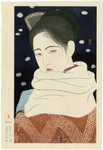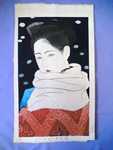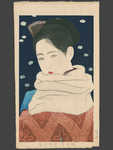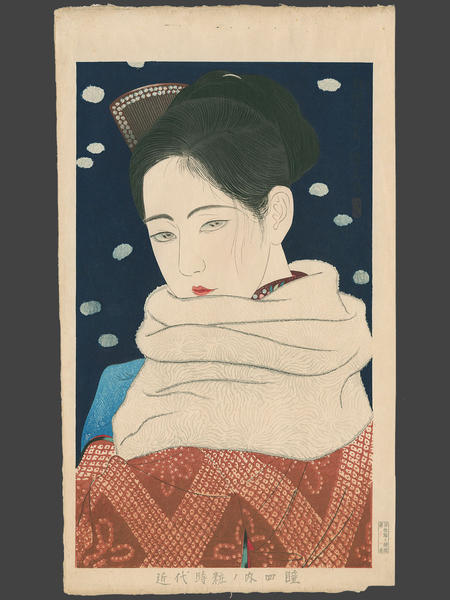| | |
| Artist: | Kiyoshi Kobayakawa (1898-1948) — 小早川清 |
| Title: | Expression of Eyes — 瞳 |
| Series: | Womens manners of today |
| Date of first edition?: | 1931/1 |
| Date of this artwork?: | 1931 (may not be accurate) |
| Publisher (first edition)?: | Private |
| Publisher (this edition)?: | Private |
| Medium (first edition): | Woodblock |
| Medium (this edition): | Woodblock |
| Format (first edition): | Large Oban
|
| Format (this edition): | Large Oban |
| DB artwork code: | 43834 |
| Notes (first edition)?: |
Kobayakawa Kiyoshi, 1896-1948
Styles of Women's manners of today: no. 4, Pupil of the Eye (Kindaijisesho no uchi: Hitomi)
Dated and signed at upper right (difficult to see against midnight blue ground), Showa rokunen ichigatsu (Showa 6 [1931], lst month) Kiyoshi saku with artist's seal Kobayakawa; the title Kindaijisesho no uchi non- Hitomi, along the lower margin, and limited edition seal on the right margin, Hyaku mai kagiri zeppan, dai ni go (100 limited edition), privately published, the blocks carved by Takano Shichinosuke and printed by Ono Tomisaburo, 1931
dai oban tate-e 21 by 12 1/8 in., 53.3 by 30.7 cm
A later edition of this scene was published some time after April 1977 (so late 1970s/early 1980s).
References:
Katô, Junzô, comp., Kindai Nihon hanga taikei, 1975-76, Vol. III Reigle Stephens, Amy, gen. ed., The new wave: Twentieth-century Japanese prints from the Robert O. Muller Collection, 1993, pp. 176-177, pl. 221
Reigle Newland, Amy, and Hamanaka Shinji, The Female Image: 20th century prints of Japanese beauties, 2000, p. 143, pl. 192
Nihon no hanga III 1921-1930, Toshi to onna to hikari to kage to (Japanese Prints III, 1921-1930: Cities and Women, Lights and Shadows), Chiba City Museum of Art, 2001, p. 122, pl. 264-4
Reigle Newland, Amy, gen. ed., Printed to Perfection: Twentieth-century Japanese Prints from the Robert O. Muller Collection, Arthur M. Sackler Gallery, 2004, p. 96, no. 82
Notes Kiyoshi's best design after Tipsy. Limited edition. Rare. |
|
| Notes (this edition)?: |
| The following information was taken from the original web listing of this artwork. Note that there may be some inaccuracies:
Condition Fine impression, color and condition.
Edition 11(?) |
|
| Artist Bio: |
Kobayakawa Kiyoshi is best known for designing woodblock prints of modern Japanese women. Born in Hakata, a town in the Fukuoka Province of Kyushu, Kiyoshi was one of many artists who studied with Kaburagi Kiyokata, the famous painter and print designer. Kiyoshi entered Kiyokata's school at age twenty and probably knew Kiyokata's other students including Ito Shinsui, Kawase Hasui, and Torii Kotondo. Unfortunately, little is known about Kiyoshi's life compared to those other print designers. During the 1920's and 1930's, he exhibited Nihonga (Japanese-style) paintings at several exhibitions including the Kyodokai and the Imperial Academy Exhibition. In 1923, he contributed a print design to the series, "Complete Collection of Chikamatsu". This was probably Kiyoshi's first experience designing woodblock prints. Beginning in 1930, Kiyoshi began designing a series of six bijin prints which he called "Modern Fashionable Styles" (Kindai jisei sho). These prints were carved by Tadano Shichinosuke and printed by Ono Tomisaburo. The prints in this series were (1) Tipsy, (2) Powdering the Face, (3) Pedicure, (4) Expression of Eyes, (5) Black Hair, and (6) Rouge. Though most of these prints depict Japanese women engaged in traditional feminine pursuits, Tipsy is remarkable for its frank portrayal of a modern girl, or moga. It depicts a Japanese woman dressed in fashionable Western clothing and jewelry, drinking and smoking a cigarette. Her flirtatious, blurred gaze and her flushed cheeks indicate that she is intoxicated. This print was considered quite risque when it was first published. Kiyoshi designed thirteen prints in all, twelve of which were exhibited at the 1936 Toledo Exhibition. In addition to his six self-published prints, three were published by Hasegawa, three by Ensendo (Takamizawa) and one by Watanabe Shozaburo. Kiyoshi was awarded the special rank of Tokusen for his 1933 print, The Geisha Ichimaru. He died in April 1948 at Ikegami, Tokyo. Some of his woodblocks have been reprinted since his death and have later publisher's seals in the margin. Kobayakawa Kiyoshi is best known for designing woodblock prints of modern Japanese women. Born in Hakata, a town in the Fukuoka Province of Kyushu, Kiyoshi was one of many artists who studied with Kaburagi Kiyokata, the famous painter and print designer. Kiyoshi entered Kiyokata's school at age twenty and probably knew Kiyokata's other students including Ito Shinsui, Kawase Hasui, and Torii Kotondo. Unfortunately, little is known about Kiyoshi's life compared to those other print designers. During the 1920's and 1930's, he exhibited Nihonga (Japanese-style) paintings at several exhibitions including the Kyodokai and the Imperial Academy Exhibition. In 1923, he contributed a print design to the series, "Complete Collection of Chikamatsu". This was probably Kiyoshi's first experience designing woodblock prints. Beginning in 1930, Kiyoshi began designing a series of six bijin prints which he called "Modern Fashionable Styles" (Kindai jisei sho). These prints were carved by Tadano Shichinosuke and printed by Ono Tomisaburo. The prints in this series were (1) Tipsy, (2) Powdering the Face, (3) Pedicure, (4) Expression of Eyes, (5) Black Hair, and (6) Rouge. Though most of these prints depict Japanese women engaged in traditional feminine pursuits, Tipsy is remarkable for its frank portrayal of a modern girl, or moga. It depicts a Japanese woman dressed in fashionable Western clothing and jewelry, drinking and smoking a cigarette. Her flirtatious, blurred gaze and her flushed cheeks indicate that she is intoxicated. This print was considered quite risque when it was first published. Kiyoshi designed thirteen prints in all, twelve of which were exhibited at the 1936 Toledo Exhibition. In addition to his six self-published prints, three were published by Hasegawa, three by Ensendo (Takamizawa) and one by Watanabe Shozaburo. Kiyoshi was awarded the special rank of Tokusen for his 1933 print, The Geisha Ichimaru. He died in April 1948 at Ikegami, Tokyo. Some of his woodblocks have been reprinted since his death and have later publisher's seals in the margin.
|
|







